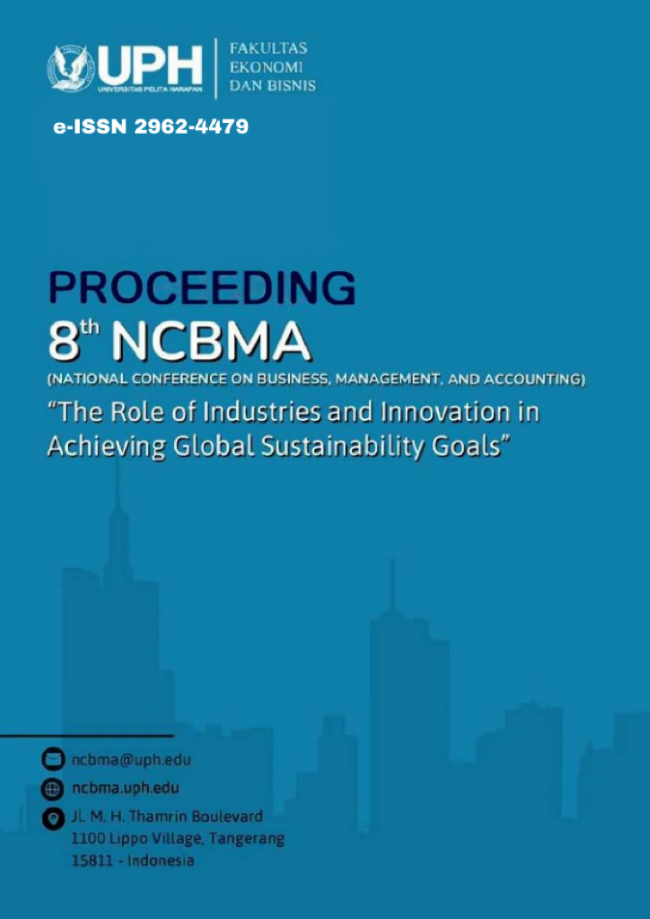CONSUMER WILLINGNESS TO PAY FOR SUSTAINABLE PRODUCTS
Λέξεις-κλειδιά:
Sustainable products, willingness to pay premium price, brand image, environmental awareness, sustainable fashionΠερίληψη
The growing awareness of sustainability among consumers in Indonesia has led to a significant shift in preferences towards more environmentally friendly products, particularly in the fashion industry. This shift has been particularly evident in the case of Sejauh Mata Memandang, a fashion brand committed to sustainability. However, despite the increasing awareness, there is limited research on how far consumers are willing to pay a premium for sustainable fashion products. This study aims to explore the factors that influence consumers' willingness to pay a premium price for sustainable fashion products, specifically focusing on Sejauh Mata Memandang. The factors examined include Environmental Awareness, Price, Product Quality, and Trendiness, with the goal of understanding how these elements contribute to Brand Image, and how Brand Image influences the willingness to pay a premium price. Using a quantitative approach, data was collected from 200 consumers who have purchased Sejauh Mata Memandang products. The findings reveal that Environmental Awareness, Price, and Product Quality have a significant effect on Brand Image, which, in turn, influences consumers' willingness to pay premium prices. However, Trendiness did not show a significant impact on Brand Image in the case of Sejauh Mata Memandang. This research contributes to the academic discussion on sustainable marketing and consumer behavior in emerging markets, offering valuable insights for brands and policymakers to develop more effective marketing strategies and sustainability-oriented policies.
Αναφορές
Bamberg, S. and Möser, G. (2007) ‘Twenty years after Hines, Hungerford, and Tomera: A new meta-analysis of psycho-social determinants of pro-environmental behaviour’, Journal of Environmental Psychology, 27(1), pp. 14–25. Available at: https://doi.org/10.1016/j.jenvp.2006.12.002.
Chaudhuri, A. and Holbrook, M.B. (2001) ‘The chain of effects from brand trust and brand affect to brand performance: The role of brand loyalty’, Journal of Marketing, 65(2), pp. 81–93. Available at: https://doi.org/10.1509/jmkg.65.2.81.18255.
Kapferer, J.-N. (888) ‘NON-COMPLET The New Strategic Brand Management : Advanced Insights and Strategic Thinking’, pp. 181, 188–193, 195–205, 208–212.
Malarvizhi, C.A. et al. (2022) ‘Modelling the significance of social media marketing activities, brand equity and loyalty to predict consumers’ willingness to pay premium price for portable tech gadgets’, Heliyon, 8(8), p. e10145. Available at: https://doi.org/10.1016/j.heliyon.2022.e10145.
Mehta, C.M. et al. (2014) ‘Compost: Its role, mechanism and impact on reducing soil-borne plant diseases’, Waste Management, 34(3), pp. 607–622. Available at: https://doi.org/10.1016/j.wasman.2013.11.012.
Review, I.E. (2023) ‘Received : 10-04-2023’, 01, pp. 26–53.
Vlek, C.A.J. and Steg, L. (2007) ‘Human behavior and environmental sustainability: Problems, driving forces, and research topics’, Journal of Social Issues, 63(1), pp. 1–19. Available at: https://doi.org/10.1111/j.1540-4560.2007.00493.x.
Zeithaml, A.V. (1988) ‘Persepsi Konsumen Nilai Sarana-Akhir : Kualitas , Sintesis Model dan Bukti’, Jurnal Asosiasi Pemasaran Amerika, 52(3), pp. 2–22.
Λήψεις
Δημοσιευμένα
Τεύχος
Ενότητα
Άδεια

Αυτή η εργασία είναι αδειοδοτημένη υπό το Creative Commons Attribution-ShareAlike 4.0 International License.

